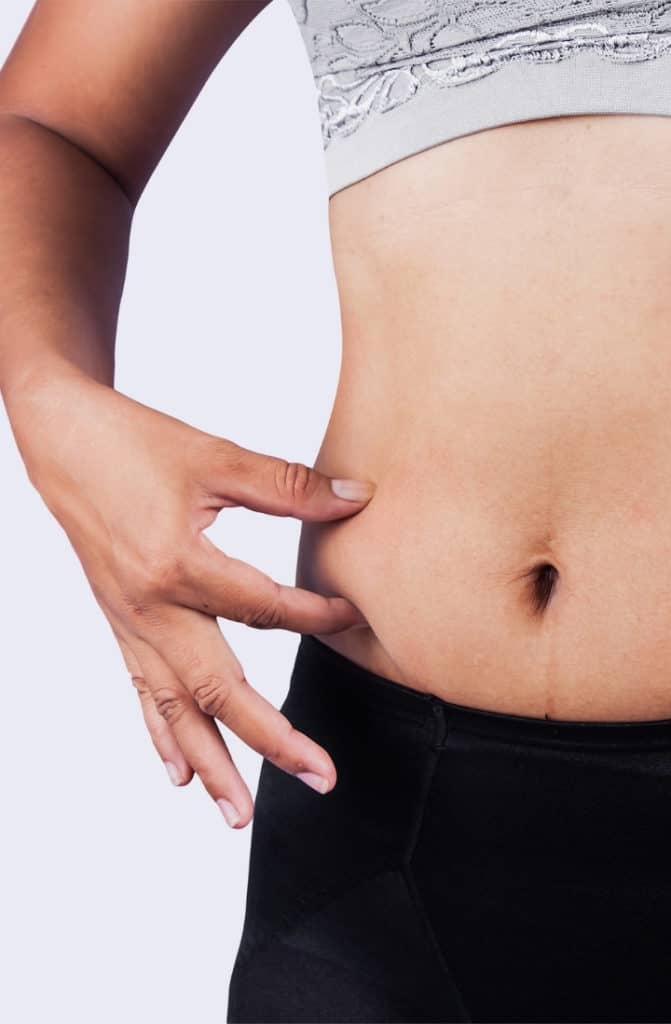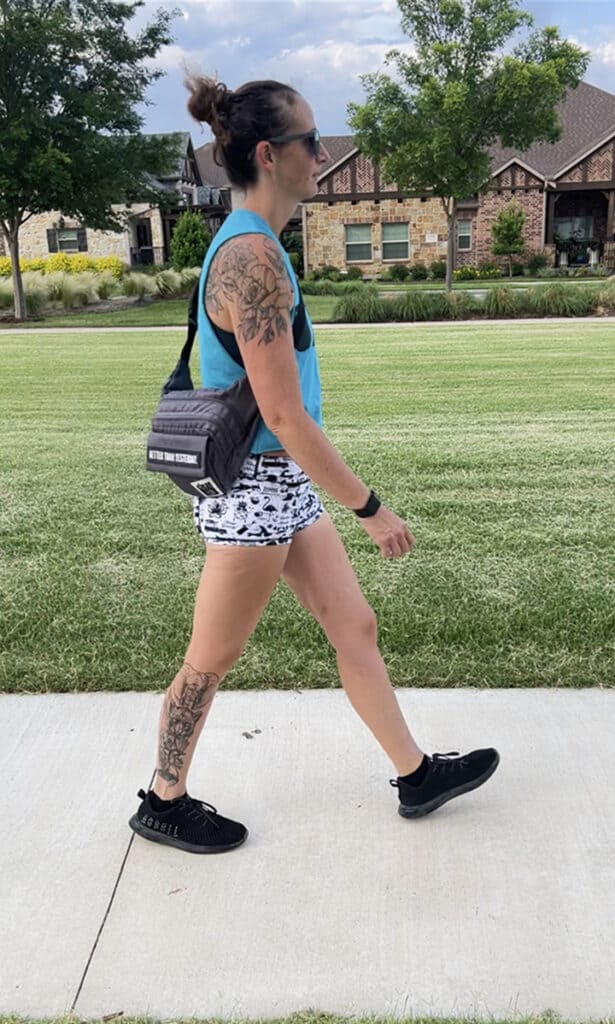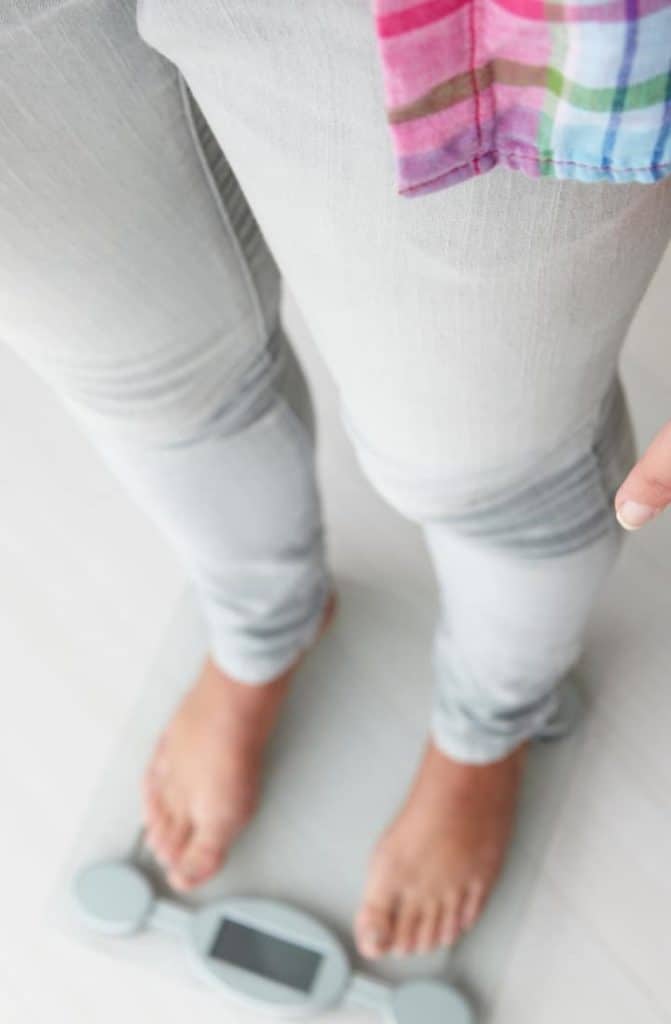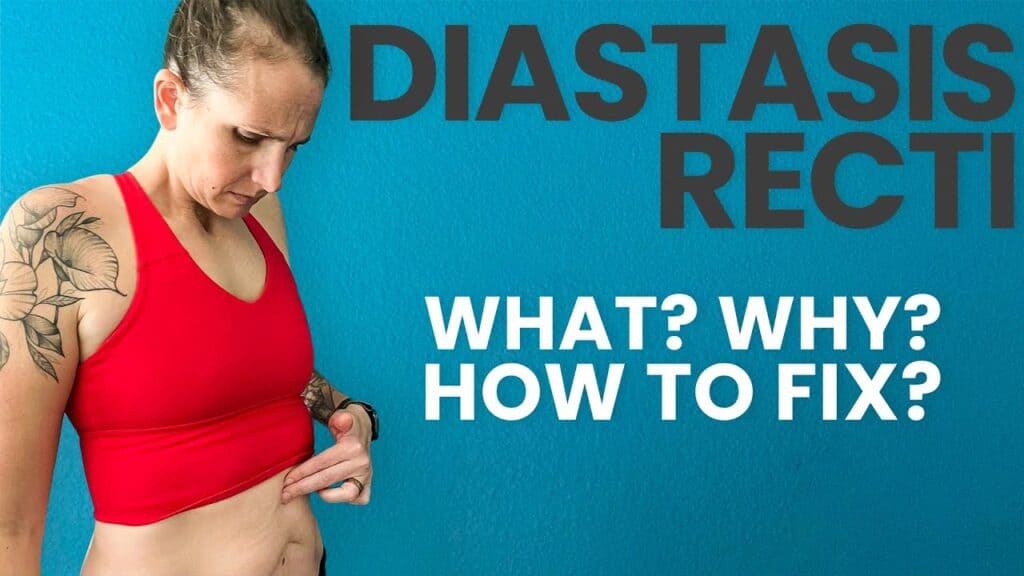Diastasis Recti happens when the connective tissue in your abs separates. To learn if you have it and how to fix it, read on!
Have you heard of Diastasis Recti? Not many of us have, I’ve learned and I for one, did not know about it until my 4th child was 3 years old.
So you are not alone in being unaware of the condition. And if you have Diastasis Recti, well, you aren’t alone there either!
In this post, I’ll share why Diastasis Recti occurs, what the signs are, and ways that you can work toward correcting it.
Don’t worry – this is actually more common than you know and with some specific exercises (and with time too), the separation that has taken place can be corrected.
Read on for more information, continue to eat healthily, drink plenty of water, and above all, take time for you!
What Is Diastasis Recti?
Diastasis Recti is a separation of the left and right sides of the outermost abdominal (stomach) muscle. It's often most evident when you strain your abdominal muscles, such as when you do a sit-up or when you cough.
The condition is known as Diastasis Rectus Abdominus, DR, or Abdominal Separation too.
Here’s a little rundown as an explanation:
The Rectus Abdominus is divided into 2 sides, each of them running along the front of your stomach. A band of tissue is found in between – it’s called the linea alba – and when it gets thin and pulls apart, Diastasis Recti occurs.
Who can get Diastasis Recti, you ask? It’s most commonly seen in pregnant women but infants, older women, and men can get DR. Studies show that it’s most often acquired by pregnant women (in the 3rd trimester incidence of the condition is as high as 66%). Obesity and prior abdominal surgery can cause Diastasis Recti, and it can be congenital also.

Can I Get Diastasis Recti When I'm Pregnant?
Diastasis Recti in pregnancy occurs when the muscles in the abdomen stretch because of the expanding abdomen as the uterus gets bigger. When the rectus muscles become too separated, DR can occur. It doesn’t happen to everyone but if you are small and fit, 35 or older, are carrying a large baby to term, or are carrying multiple babies, you are more likely to see DR happen.
Diastasis Recti typically happens in the 2nd or 3rd trimester because the baby is growing rapidly and therefore, your abdomen is too! This puts a lot of pressure on the abdomen, causing a gap that does not always correct itself after the baby is born. Postpartum is when DR is often noticed for the first time.
What Are Other Reasons For Diastasis Recti?
Besides pregnancy, there are a few reasons for the condition to possibly occur.
- Rapid changes in weight
- Frequent changes in weight
- Back-to-back pregnancies
- Genetics
- Stomach obesity
- Improper form when doing heavy lifting (this can happen, for example, if your weight lifting technique is wrong and you overload the stomach wall)
What Are The Symptoms Of Diastasis Recti?
People with Diastasis Recti may experience a separation of the stomach muscles, visibly seen and felt when touching the stomach. The following symptoms can also be evident.
- Pelvic, low back, or hip pain
- Difficulty lifting objects
- Midsection weakness
- Poor trunk posture
- Feeling of flabbiness in the stomach muscles
- Tenting or doming of the middle of the stomach, especially noticed when rolling over in bed, doing exercises that involve the stomach, and when lifting

Do I Have Diastasis Recti?
What does your stomach look like if you have Diastasis Recti?
You can do a self examination of the abdomen to check for DR by placing your fingers on your abs, pressing above and below the belly button, and looking for a gap larger than 2 fingers.
Are you worried that you may have Diastasis Recti? Follow these steps:
- Lie on your back, with your knees bent and your feet on the floor.
- Place your hand's palm down over your belly, with your fingers pointing toward your toes.
- Press your fingers gently into your navel area, then slowly lift your head, drawing your chin to your chest. This causes your core to tighten.
- You’ll be pressing above and below the belly button as I mentioned above, looking for a gap. In my video on Diastasis Recti at the beginning of this post, I give a demo on checking for DR, or you can check here.
- If you feel a gap of at least two finger widths between the muscles as they contract, you have a diastasis. A gap as wide as four or five fingers is considered severe. Repeat the procedure both above and below because the separation may be wider in different places.
You may see a bulge in your abdomen that does not go away and you’ll notice a dome-like appearance when you move certain ways, like when getting out of bed.
It’s important to note that if you are 6 weeks postpartum or less, you quite likely will feel this gap. Wait until you are further along postpartum to try this test, after your body has had more time to get back in form. Remember, our bellies stretch a lot when we carry a child!
If you think you have DR and are concerned, see your health provider to verify your suspicions and to give you peace of mind. You may be given exercises to do or a referral to a specialist if needed.
Should I See A Doctor For My Diastasis Recti?
If you are concerned about the DR, yes, see your doctor or healthcare provider. Also, if you have tried physical therapy and it does not seem to be helping, check with your doctor. And, of course, if you are feeling pain, it’s essential to be examined too. Sometimes an ultrasound is used.
If surgery is recommended, the abdominal walls will be stitched together again along the midline. In some instances, the procedure is taken care of laparoscopically (using a tiny camera and instruments inserted through small incisions), while in other cases, abdominal surgery takes place with an incision.
Surgery will be an option if you are not planning to have more kids, so if you are, you will be told to wait because your abs will stretch and separate again with subsequent pregnancies.

How Can I Fix Diastasis Recti?
Exercise is an effective way to repair DR. Remember, if you’ve recently had a baby, don’t worry just yet. Allow your body to heal and then get the go-ahead from your doctor to exercise. In fact, anyone who has Diastasis Recti may want to check with a doctor or physical therapist to learn about effective and safe ways to strengthen the core.
Building a strong core is important for a lot of reasons, and that’s why I stress that exercise is so important (see my post on getting your daily steps in). Balance, stability, and even things we don’t think about – like sitting properly, carrying a heavy laundry basket, enjoying our favorite sport, and walking with good posture are affected by a strong core.
Gentle and consistent exercise will help (avoid tough exercises like the plank and crunches as you repair your DR). Try these exercises in 3 - 4 sets, 2 to 3 times weekly.
Drawing In:
"Drawing In" is the process of contracting/flexing your abdomen in any position – standing, laying, sitting, or during any exercise. As you contract your core, imagine "drawing in" your abs and pulling them toward your spine. Hold for 30 seconds and release, resting for a few brief seconds, and repeat 4 - 5 times.
NOTE: Even if you do not have DR, this movement is a great way to understand how to properly stabilize your core while weight lifting. Core stability is key to accurately performing great lifts!
Glute Bridge:
Lie on your back with your knees bent and feet flat on the ground. Push your glutes upward to fully extend your hips, while keeping your knees and feet in the same starting position. While contracting (squeezing) your glutes, hold this position before bringing your glutes back to the ground. Rest briefly for a few seconds then repeat. Repeat 10 - 15 times.
Heel Slides:
Lie on your back with your knees bent and feet flat on the ground. Then, slide one heel out until straight, then bring it back into the starting position. Repeat 15 - 20 times consecutively for each leg.
Table Top:
Start with your hands and knees on the ground. As you inhale, round your back and contract your abdomen (drawing in) and hold. Continue breathing while contracting and then come back to flat back. Repeat 10 - 15 times.
Single Leg Lifts:
Lie on your back with your knees bent and feet on the ground. Take one leg and extend it straight out, keeping it balanced just above the ground. Perform a leg lift by lifting your foot towards the ceiling until you feel tension, and then bring your foot back down. If you need a short period of rest you may bring your foot back to the ground. Complete 15 - 20 reps for each leg.
For each of these exercises, I do 3 sets. I saw results with these exercises after about 4 or 5 months. Slow and steady is key. Maintaining good form is important too, so take care and do the exercises properly. And don’t overdo it – the results will not come any faster.

What Happens if Diastasis Recti Goes Untreated?
If you leave Diastasis Recti untreated, you may have issues like weakened rectus abdominis muscles (this means your straight abdominal muscles or your abs). This can lead to lower back pain and even cause mobility issues. Why is this? A tummy with weak form in the core muscles, obliques, and transverse abdominis can mean a whole lot more than poor posture.
Urinary incontinence is sometimes seen (and that can be a nuisance and affect your quality of life too), although studies haven't determined that DR is solely linked to pelvic floor function. So working to improve the diaphragm, transverse abdominis, pelvic floor muscles, and all ab muscles using the exercise program I've outlined above is a good start.
But if you are hesitant to tackle the issue on your own, you can also speak with a knowledgeable certified personal trainer to help you with proper form and intensity. And if you've recently had a baby, it's best to get advice from the doctor before starting any postpartum exercise.
Afraid you have severe Diastasis Recti because your tummy has an unusual bulge several months postpartum? See your doctor to get advice. Diastasis Recti surgery is not always needed but in the case of an accompanying umbilical hernia or severe ab separation, it is sometimes done.
Is It Ever Too Late To Fix Diastasis Recti?
No, it’s never too late to fix Diastasis Recti. Studies have proven just how effective core strength training can be, and if you work at it just like you do with your clean eating lifestyle and other forms of self-care, you will see results.
DR is normal because your baby has a lot of growing to do over 9 months! Carrying a child, while wonderful, takes its toll on our bodies. As moms, we owe it to ourselves to spend time taking care of ourselves (see my post on the best time to workout because you deserve it).
Remember, it will take time to heal and this will depend on the severity of your DR. See your doctor or try physical therapy if you have any concerns at all about your Diastasis Recti. And if you’d like help with focusing on your health, including exercise and eating right, check out my Cleanish Movement program. It just may be what you need for self-care and feeling good!
This post contains affiliate links for products I use regularly and highly recommend.



Indian Crackers
Thank you for sharing your information.